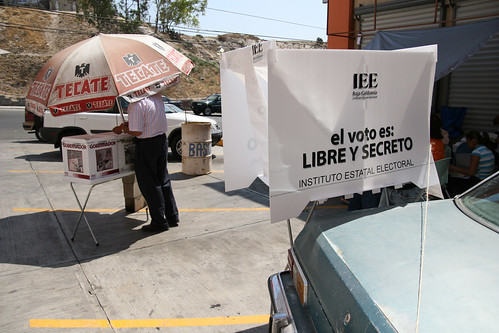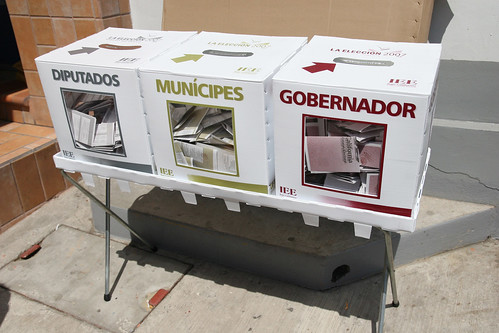I’ve taken my camera with me to vote for the last several elections resulting in both good and bad experiences. When San Diego used touch-screen machines for the first time, I was able to get a shot using my digital SLR. On another election day, I was stopped and aggressively questioned by a poll worker for trying to take a cellphone photo.
Here’s the problem. The legality of cameras inside polling places isn’t black and white; the laws vary state by state. Plus, some poll workers have only received basic training and will apply their own judgement. The Citizen Media Law Project suggests four things to avoid getting yourself into trouble: follow the rules, be discreet, don’t interfere with voters or the process, respect the buffer zone.
In California, election codes aren’t particularly clear. They prohibit recording within 100 feet of anyone entering or exiting the polling place with the intent to dissuade others from voting. This is where the above guidelines come in; stay low-key and they’ll likely leave you alone. I spoke with the San Diego County Registrar of Voters and they said photography and video will be allowed up to 25 feet away.
While inside the polling area, California Elections Code says you must be in the process of voting (i.e. not using a camera), are limited to 10 minutes, and can’t show your vote to others (i.e. not documenting your vote). While it doesn’t specifically state “no cameras allowed,” legal precedent hasn’t cleared up the specifics. Government officials err on the side of caution. The California Secretary of State’s office says it has “historically taken the position that use of cameras or video equipment at polling places is prohibited, though there may be circumstances where election officials could permit such use.” When I spoke to the San Diego County Registrar of Voters, they said they won’t allow cameras inside the polling place except for credentialed journalists.
From a certain angle, this all seems very oppressive. This is a free country and I should have the right to video my vote, right? Yes, but other voters should also have the right not to be surveilled while voting. Poll workers are commissioned to protect the vote and can kick you out, even calling the police if you cause enough of a disturbance. This can all be avoided by sticking to the suggestions mentioned above. Pay attention and be careful not to record other people unwillingly.
Publish Your Photos and Videos on Election Day
- YouTube and PBS have partnered with Video Your Vote to gather first-hand accounts on election day. They’ve arranged the videos on a map to note voter intimidation and other problems at the polls.
- The New York Times’ Polling Place Photo Project collects images to create “an archive of photographs that captures the richness and complexity of voting in America.”
- Video The Vote is a watchdog group organizing people to document voter suppression and other problems.




